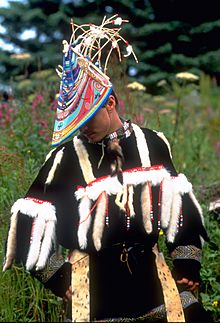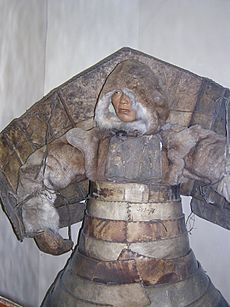Alutiiq facts for kids

A Sugpiaq dancer
|
|
| Total population | |
|---|---|
| 4.000-12.000 | |
| Regions with significant populations | |
| Languages | |
| Sugcestun, English, Russian | |
| Religion | |
| Russian Orthodox Church, traditional religion | |
| Related ethnic groups | |
| Yup'ik, Aleut |
The Alutiiq people (say "ah-LOO-tik") are a group of Alaska Natives who live along the southern coast of Alaska. They are also known by their traditional name, Sugpiaq (say "SOOG-pee-ak"). Other names for them include Pacific Eskimo or Pacific Yupik.
Their original homes were in places like Prince William Sound and the outer Kenai Peninsula. This group is called Chugach Sugpiaq. Another group, the Koniag Alutiiq, lived on the Kodiak Archipelago and the Alaska Peninsula. In the early 1800s, about 13,000 Alutiiq people lived in over 60 villages on the Kodiak archipelago. Today, more than 4,000 Alutiiq people live in Alaska.
Contents
Understanding the Names of the Alutiiq People
The most common name used today is Alutiiq. The word Alutiiq comes from the Russian word for "Aleut". Russian fur traders and settlers started using this name when they arrived in the region.
Why are there different names?
Russian traders came to Alaska in 1784. This time was difficult for the Sugpiaq people. A sad event happened at Refuge Rock (Awa'uq) near Sitkalidak Island. Many Sugpiat people were killed there.
Because of this history, some Alaska Natives prefer to use their own names. They use Sugpiaq (meaning "the real people") to describe themselves. They use Sugstun or Sugcestun for their language.
Today, people use all three names: Alutiiq, Aleut, and Sugpiaq. It often depends on what someone prefers. Over time, many other names have been used for these people.
Alutiiq Culture and Lifestyle
The Alutiiq people have always lived near the coast. They traditionally got most of their food from the ocean. They fished for salmon and halibut. They also hunted whales.
Traditional Homes and Food Gathering
Besides ocean foods, they also gathered berries and hunted land animals. Before Europeans arrived, they lived in special homes called ciqlluaq. These were semi-underground houses.
Today, Alutiiq people live in modern homes in coastal fishing towns. They work in many different jobs in the modern world. But they still value their traditional ways of getting food. This is called subsistence living.
The Alutiiq Language Today
The Alutiiq language is very important to the people. In 2010, the high school in Kodiak started teaching the Alutiiq language. Students had asked for this.
The Alutiiq language is part of the Eskaleut languages family. It belongs to the Yup'ik branch of these languages. In Kodiak, only about 50 older people spoke the local dialect. The language was in danger of disappearing. Teaching it in schools helps keep it alive.
Notable Alutiiq People
- Alvin Eli Amason, a talented painter and sculptor.
- Linda Infante Lyons, a painter and muralist.
- Cungagnaq, also known as Peter the Aleut, an Eastern Orthodox saint. He was reportedly from Kodiak Island.
- Loren Leman, who served as the Lieutenant-governor of Alaska from 2002 to 2006.
- Sven Haakanson, the executive director of the Alutiiq Museum. He won a special award called a 2007 MacArthur Fellowship.
See also
 In Spanish: Alutiiq para niños
In Spanish: Alutiiq para niños




